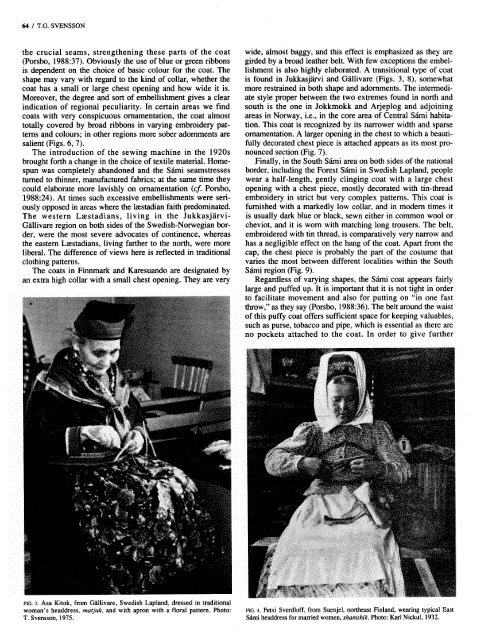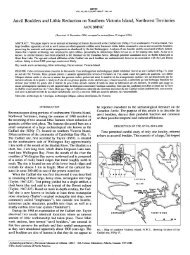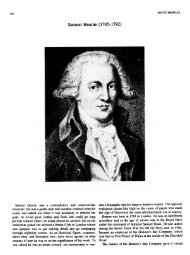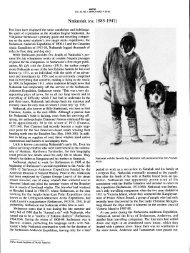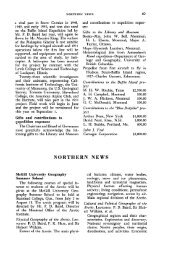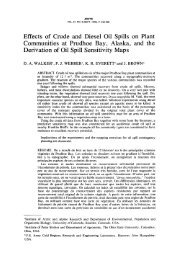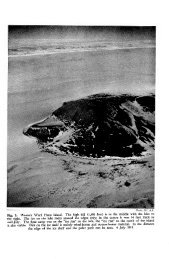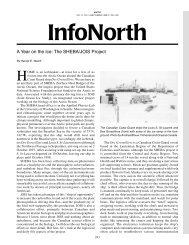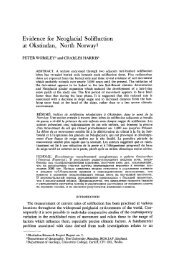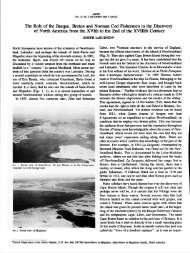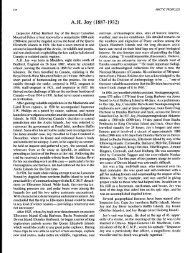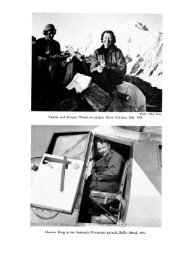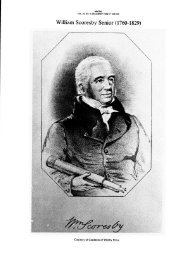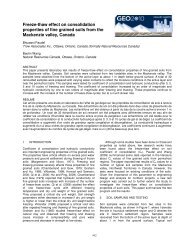Clothing in the Arctic - AINA Publications Server
Clothing in the Arctic - AINA Publications Server
Clothing in the Arctic - AINA Publications Server
You also want an ePaper? Increase the reach of your titles
YUMPU automatically turns print PDFs into web optimized ePapers that Google loves.
64 I T.G. SVENSSON<br />
<strong>the</strong> crucial seams, streng<strong>the</strong>n<strong>in</strong>g <strong>the</strong>se parts of <strong>the</strong> coat<br />
(Porsbo, 1988:37). Obviously <strong>the</strong> use of blue or green ribbons<br />
is dependent on <strong>the</strong> choice of basic colour for <strong>the</strong> coat. The<br />
shape may vary with regard to <strong>the</strong> k<strong>in</strong>d of collar, whe<strong>the</strong>r <strong>the</strong><br />
coat has a small or large chest open<strong>in</strong>g and how wide it is.<br />
Moreover, <strong>the</strong> degree and sort of embellishment gives a clear<br />
<strong>in</strong>dication of regional peculiarity. In certa<strong>in</strong> areas we f<strong>in</strong>d<br />
coats with very conspicuous ornamentation, <strong>the</strong> coat almost<br />
totally covered by broad ribbons <strong>in</strong> vary<strong>in</strong>g embroidery pat-<br />
terns and colours; <strong>in</strong> o<strong>the</strong>r regions more sober adornments are<br />
salient (Figs. 6,7).<br />
The <strong>in</strong>troduction of <strong>the</strong> sew<strong>in</strong>g mach<strong>in</strong>e <strong>in</strong> <strong>the</strong> 1920s<br />
brought forth a change <strong>in</strong> <strong>the</strong> choice of textile material. Home-<br />
spun was completely abandoned and <strong>the</strong> Simi seamstresses<br />
turned to th<strong>in</strong>ner, manufactured fabrics; at <strong>the</strong> same time <strong>the</strong>y<br />
could elaborate more lavishly on ornamentation (cf. Porsbo,<br />
1988:24). At times such excessive embellishments were seri-<br />
ously opposed <strong>in</strong> areas where <strong>the</strong> laestadian faith predom<strong>in</strong>ated.<br />
The western Laestadians, liv<strong>in</strong>g <strong>in</strong> <strong>the</strong> Jukkasjarvi-<br />
Gallivare region on both sides of <strong>the</strong> Swedish-Norwegian bor-<br />
der, were <strong>the</strong> most severe advocates of cont<strong>in</strong>ence, whereas<br />
<strong>the</strong> eastern Laestadians, liv<strong>in</strong>g far<strong>the</strong>r to <strong>the</strong> north, were more<br />
liberal. The difference of views here is reflected <strong>in</strong> traditional<br />
cloth<strong>in</strong>g patterns.<br />
The coats <strong>in</strong> F<strong>in</strong>nmark and Karesuando are designated by<br />
an extra high collar with a small chest open<strong>in</strong>g. They are very<br />
FIG. 3. Asa Kitok, from Gallivare, Swedish Lapland, dressed <strong>in</strong> traditional<br />
woman’s headdress, marjuk, and with apron with a floral pattern. Photo:<br />
T. Svensson, 1975.<br />
wide, almost baggy, and this effect is emphasized as <strong>the</strong>y are<br />
girded by a broad lea<strong>the</strong>r belt. With few exceptions <strong>the</strong> embel-<br />
lishment is also highly elaborated. A transitional type of coat<br />
is found <strong>in</strong> JukkasjWi and Gallivare (Figs. 3, €9, somewhat<br />
more restra<strong>in</strong>ed <strong>in</strong> both shape and adornments. The <strong>in</strong>termedi-<br />
ate style proper between <strong>the</strong> two extremes found <strong>in</strong> north and<br />
south is <strong>the</strong> one <strong>in</strong> Jokkmokk and Arjeplog and adjo<strong>in</strong><strong>in</strong>g<br />
areas <strong>in</strong> Norway, i.e., <strong>in</strong> <strong>the</strong> core area of Central Simi habita-<br />
tion. This coat is recognized by its narrower width and sparse<br />
ornamentation. A larger open<strong>in</strong>g <strong>in</strong> <strong>the</strong> chest to which a beauti-<br />
fully decorated chest piece is attached appears as its most pro-<br />
nounced section (Fig. 7).<br />
F<strong>in</strong>ally, <strong>in</strong> <strong>the</strong> South S hi area on both sides of <strong>the</strong> national<br />
border, <strong>in</strong>clud<strong>in</strong>g <strong>the</strong> Forest S hi <strong>in</strong> Swedish Lapland, people<br />
wear a half-length, gently cl<strong>in</strong>g<strong>in</strong>g coat with a large chest<br />
open<strong>in</strong>g with a chest piece, mostly decorated with t<strong>in</strong>-thread<br />
embroidery <strong>in</strong> strict but very complex patterns. This coat is<br />
furnished with a markedly low collar, and <strong>in</strong> modem times it<br />
is usually dark blue or black, sewn ei<strong>the</strong>r <strong>in</strong> common wool or<br />
cheviot, and it is worn with match<strong>in</strong>g long trousers. The belt,<br />
embroidered with t<strong>in</strong> thread, is comparatively very narrow and<br />
has a negligible effect on <strong>the</strong> hang of <strong>the</strong> coat. Apart from <strong>the</strong><br />
cap, <strong>the</strong> chest piece is probably <strong>the</strong> part of <strong>the</strong> costume that<br />
varies <strong>the</strong> most between different localities with<strong>in</strong> <strong>the</strong> South<br />
Shi region (Fig. 9).<br />
Regardless of vary<strong>in</strong>g shapes, <strong>the</strong> S hi coat appears fairly<br />
large and puffed up. It is important that it is not tight <strong>in</strong> order<br />
to facilitate movement and also for putt<strong>in</strong>g on “<strong>in</strong> one fast<br />
throw,” as <strong>the</strong>y say (Porsbo, 1988:36). The belt around <strong>the</strong> waist<br />
of this puffy coat offers sufficient space for keep<strong>in</strong>g valuables,<br />
such as purse, tobacco and pipe, which is essential as <strong>the</strong>re are<br />
no pockets attached to <strong>the</strong> coat. In order to give fur<strong>the</strong>r<br />
FIG.<br />
4. Fetsi Sverdloff, from Suenjel, nor<strong>the</strong>ast F<strong>in</strong>land, wear<strong>in</strong>g typical East<br />
Shi headdress for married women, shamshik. Photo: Karl Nickul, 1932.


